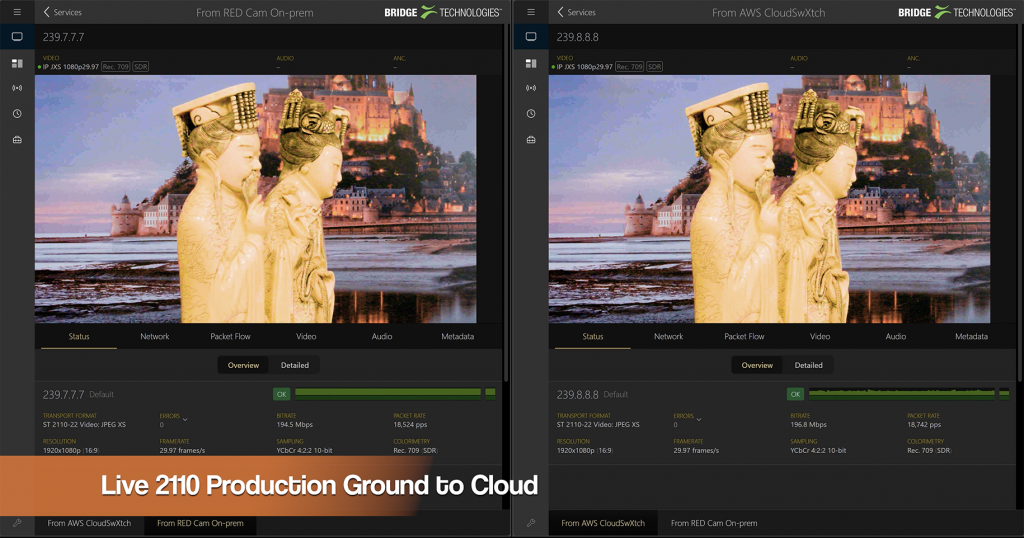Cloud Without the Confusion: Smarter Thinking for Smarter Broadcast Workflows
July 24, 2025
As seen in InBroadcast
As the broadcast industry edges ever deeper into the cloud, the conversation has moved well beyond ‘if’ and firmly into ‘how’. The benefits are well documented: scalability, elasticity, remote collaboration, reduced hardware costs – but as many have learned the hard way, simply picking up an on-prem toolkit and dropping it into a cloud instance rarely delivers the magic expected. A lift-and-shift mindset often results in a clunky hybrid that’s neither fish nor fowl: expensive, complex, and full of jitter.
When considering cloud-based services, the first question to ask isn’t ‘what can be moved to the cloud?’ but rather, ‘how should the workflow be rethought to make the most of what the cloud offers?’. Because while the cloud can replicate many of the technical behaviours of a facility – IP switching, multicast routing, signal monitoring – it does so with fundamentally different infrastructure. Replicating the behaviour is not the same as replicating the architecture. And ignoring that distinction can lead to significant operational headaches.
A second key consideration is integration. Very few workflows are fully cloud-native – most exist in some hybrid state, with live production elements, routing, or signal management still tied to the ground. So, the true challenge becomes one of seamless communication between the on-prem and cloud elements: synchronised in performance, predictable in behaviour, and transparent in control. In other words, not a workaround, but a unified extension.
That’s where recent collaboration between SwXtch.io and Bridge Technologies has opened up genuinely interesting possibilities. SwXtch’s platform enables full multicast functionality in the cloud by creating a virtual switch and bridge overlay across the infrastructure of a data centre. This allows any endpoint in the cloud to dynamically request any on-prem multicast using the same addresses and behaviour expected on the ground. If a cloud-based multiviewer needs to pull a feed from an on-prem camera, it can do so in milliseconds. No duct tape, no exotic protocols – just a virtualised extension of the facility network.

Within this extended cloud fabric, Bridge Technologies’ monitoring probes are able to operate in exactly the same way they do in a traditional environment. In one recent demonstration, a VB440 was installed on-prem, connected via SwXtch to a cloud instance, and used to monitor an uncompressed SMPTE 2110 stream as it passed through the cloud and returned on a new multicast address. The probe locked to both the native and round-tripped signals without issue: same framerate, same resolution, only 1–2 frames of latency for the entire roundtrip. On reserved bandwidth, latency dropped to just milliseconds.
Crucially, this was achieved without proprietary formatting or compression. JPEG XS, uncompressed, compressed, it made no difference. Bridge Technologies’ tools function across the board, offering high-precision insight with minimal disruption to existing workflows. It’s this ability to operate as a natural extension of the production infrastructure – rather than a special-case workaround – that sets the integration apart.
And for compressed stream monitoring or transformation tasks, the VB220 performs just as comfortably. In another demonstration, a 50-fps stream was converted to 59.94 fps using Tachyon Live, multicast through the cloud, and verified in full using the VB220. The combination of multicast integrity and media visibility meant the entire operation remained both traceable and trustworthy – an essential factor in fast-paced live environments.

Another key strength lies in control. Because Bridge scopes are NMOS-compatible, existing router panels on-prem can communicate directly with devices across the cloud – addressing, discovering, and commanding them just as if they were local. That means operational workflows remain intact, even as the infrastructure stretches into the cloud.
For many broadcasters, multicast in the cloud has long sounded like a contradiction in terms. But the SwXtch and Bridge Technologies integration proves otherwise. It delivers one-to-many IP-based workflows using standard functionality: no proprietary transport layers, no multiple compressions, and no compromises on latency. This is cloud done on broadcast’s terms.
And while the proof lies in the performance, the attitude behind the project is equally telling: a willingness to challenge assumptions, build open partnerships, and rethink the very foundations of how live production operates. If the cloud is going to be a true part of broadcast infrastructure, it will be through this kind of work – not by throwing out everything that came before, but by building smart extensions of it.